Pikes Peak
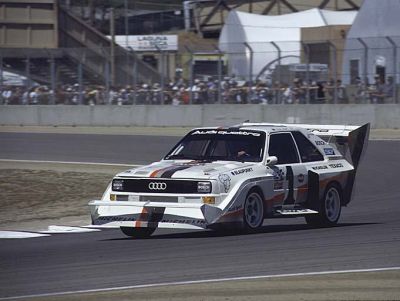 (2)
(2) (2)
(2)
|
Models
Racing
Special
Rallye Pikes Peak TransAm IMSA Talladega DTM STW DTM2000 LeMans Others |
530hp and 740Nm in the S1 (Rallye version) gave new dimensions to speed on dirty surfaces.
And with an evolution stage version (598hp), Walter "quattro" Roehrl set an new track record at the american
Pikes Peak
hill climb.
One has to mention, that there are voices saying that the normal S1 had over 550hp and the Pikespeak version even 620hp!
It seems rather agreed on that Audi folks were pretty much "understating" the power of their cars.
|
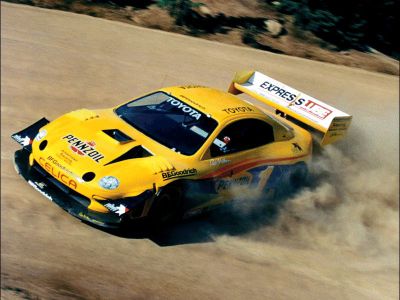 (3) | 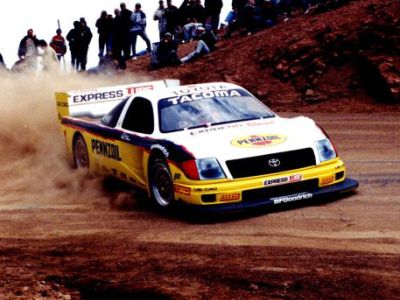 (3) |
| The Toyota Celica (left) had only the optical apperance of a normal Celica (mid engine and allwheel steering).
Of course it is a fantastic effort nevertheless. In 99 Rod Millen tried to stay under 10 minutes with a "Toyota Tacoma".
but he missed his 1994 benchmark by a few seconds, once again his car has a mid engine.
Therefore, Audi will probably keep the record for front engine cars a veeeery long time. Audi was also the only brand that could win 6 years in a row and have a "threepeat" on trackrecords. PikesPeakHillClimb takes place every year on July 4th, the american independence day. All kind of vehicles take it up the hill: Wether motorbike or heavy truck, you name it. Start is on 2866m. 20,2km (12.6 miles) of dirt and 156 bends (from pointy to longbend curves) later you arrive at the Peak in altitude of 4301m. This causes some problems for normally aspirated engines, while Turbos won't suffer as much. Considering it takes a lot of courage and crazyness to take this track without guiding fences with a car, you have to be completly mad to run up the Peak and down again only using your feet! But that is exactly what some people do every year in the probably most exhausting marathon worldwide. that too is PikesPeak.
| |
| Here are some Pikes-Peak pics from 1987, that I scanned from "Sport Auto" magazine, issue 8/1987. | ||||||||||||||
 Driftin' Walter | 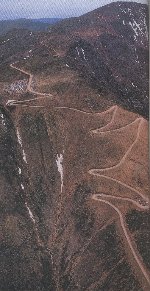 The track | 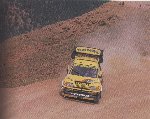 Looks nice, but is too slow. Look at the trashed front spoiler! |  VW with Bi-Engine Golf, saddly a gearbox failure close to the finish line. |  After training, descending in group. Two Peugeots against Walter- how unfair, for the Peugeots ;> | ||||||||||
Use these links if your browser cannot use the links above:| pike1a.jpg
| pike1a.jpg
| pike1a.jpg
| pike1a.jpg
| pike1a.jpg
| Walter Roehrl recorded his fabulous record that year.
| | ||||||||
| There is one nice story about Pikes Peak. When Audi came to the first qualifying session with the Batmobile, the Peugeot guys were laughing their head off: One would never need so much wings on a Pikes Peak car! Man, were they wrong: after the first session they were at first shocked and then very busy. They called the development center in France to get such wings as fast as possible. Well, Audi had done excessive windtunnel testing for months. Peugeot now was trying to overcome this advantage by working around the clock. And what is the fastest way to get things from Europe to the U.S. of A.? Right, the Concorde. She had to fly several times a day! Not very cheap, huh? Nevertheless, Peugeot had to wait till '88 to get their first win! | |
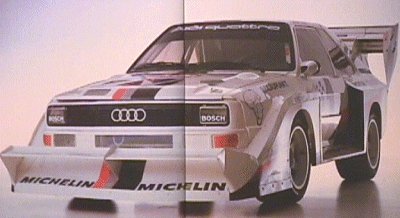 (?) | Here you can the front double wing. And the air intake in front of the rear wheel wells. On the eft side of the car, a small oil cooler is behind this opening, whereas on the right side the inlet is actually closed (thanks to Kay for telling me). The wings not only create downforce, they also lessen the house-wall like aerodynamic of the Sportquattro. |
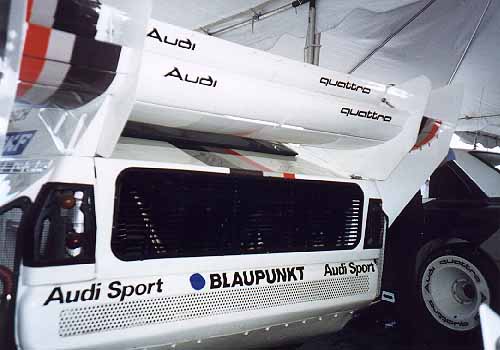 (1) | Here you can see the rear double wing, below it the air outlet of the rear mounted radiators (like the normal Rallye S1). If you look carefully you can see the ventilation openings for the wheel wells. |
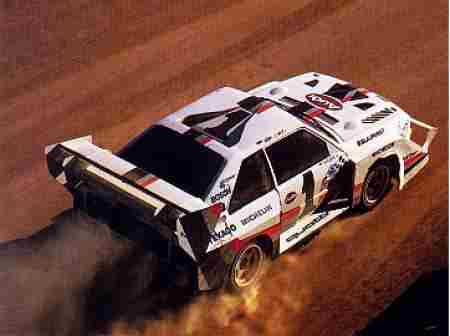 (?) | Here one can see the air outlet for the air that has streamed through the engine compartement (on the hood). Also visible are the outlets for the front wheel wells. Especially interesting is the air intake on the roof. It leads to the rear mounted water and oil coolers. Generally intake have to be positioned in areas of high pressures, outlets should be where the pressure is rather low. While this is accomplished for the outlets here, fans support the air stream for the big radiators in the back. |
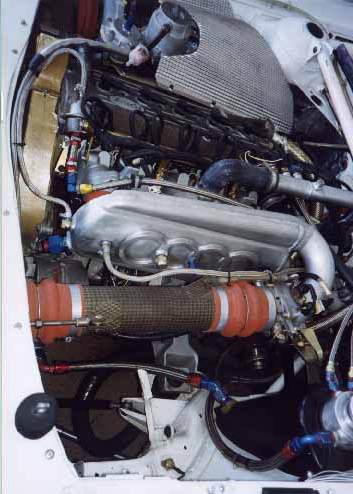 (1) | This is the heart of it all. In the background you can see the insulated or, to be precise, the wastegate valve. In the foreground you can see the intake manifold and the big pipe that transports the compressed air from the intercooler to the engine. The construction of these parts is poretty important as all cylinders have to get the same amount of air and you do not want to lose to much of the pressure. |
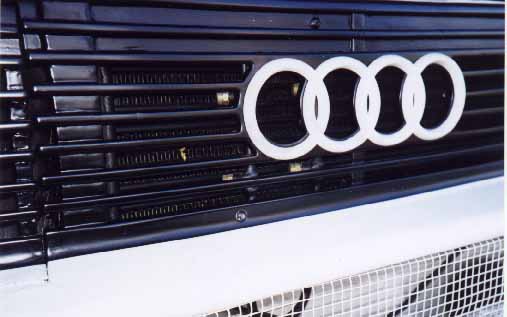 (1) | Behind the grill you can see the intercooler, which cools the air that has been heated through the process of compressing. To better its efficiency, it is water cooled. However not as in modern cars with a colsed cooling circuit. Nozzles spray water on it. The water evaporates and drains the heat from the cooler and thus the air, too. |

| Here you can see the guiding air fences on the front fenders that probably should prevent that the air flow on the surface gets turbulent.
On the back of the car you can see the air intake into the wheel wells and the outward wing plate. it looks as if this plate has the task to
"bundle" the airstream. And you can see that the wheel arches of the front fenders are rounded inwards.
Pretty many aerodynamic tools on car that is surely fast but slower as closed circuit racers. And additionally, the air flow often does not come from straight ahead. But that is the way the Peugeot crew members thought... ...till the first training
|
|
Models
Racing
Special
Rallye Pikes Peak TransAm IMSA Talladega DTM STW DTM2000 LeMans Others |